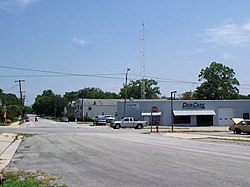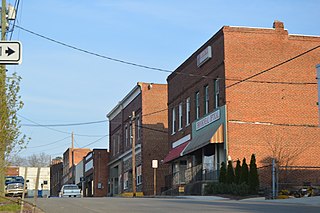
Brookneal is an incorporated town in Campbell County, Virginia, United States. The population was 1,090 as of the 2020 census. It is part of the Lynchburg Metropolitan Statistical Area.
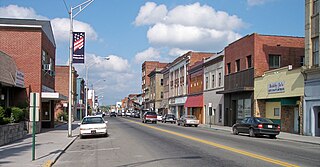
Princeton is a city in and the county seat of Mercer County, West Virginia, United States. The population was 5,872 at the 2020 census. It is part of the Bluefield micropolitan area. The city hosts the Princeton WhistlePigs baseball club of the Appalachian League.

Mullens is a city in Wyoming County, West Virginia. The population was 1,475 at the time of the 2020 census.
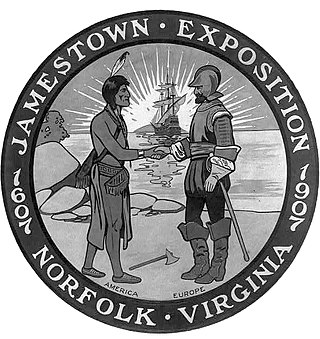
The Jamestown Exposition, also known as the Jamestown Ter-Centennial Exposition of 1907, was one of the many world's fairs and expositions that were popular in the United States in the early part of the 20th century. Commemorating the 300th anniversary of the founding of Jamestown in the Virginia Colony, it was held from April 26 to December 1, 1907, at Sewell's Point on Hampton Roads, in Norfolk, Virginia. It celebrated the first permanent English settlement in the present United States. In 1975, the 20 remaining exposition buildings were included on the National Register of Historic Places as a national historic district.

Henry Huttleston Rogers was an American industrialist and financier. He made his fortune in the oil refining business, becoming a leader at Standard Oil. He also played a major role in numerous corporations and business enterprises in the gas industry, copper, and railroads. He became a close friend of Mark Twain.

The Virginian Railway was a Class I railroad located in Virginia and West Virginia in the United States. The VGN was created to transport high quality "smokeless" bituminous coal from southern West Virginia to port at Hampton Roads.

The Norfolk and Western Railway, commonly called the N&W, was a US class I railroad, formed by more than 200 railroad mergers between 1838 and 1982. It was headquartered in Roanoke, Virginia, for most of its existence. Its motto was "Precision Transportation"; it had a variety of nicknames, including "King Coal" and "British Railway of America". In 1986, N&W merged with Southern Railway to form today's Norfolk Southern Railway.

Sewells Point is a peninsula of land in the independent city of Norfolk, Virginia in the United States, located at the mouth of the salt-water port of Hampton Roads. Sewells Point is bordered by water on three sides, with Willoughby Bay to the north, Hampton Roads to the west, and the Lafayette River to the south. It is the site of Naval Station Norfolk.

William Nelson Page was an American civil engineer and industrialist. He was active in the Virginias following the U.S. Civil War. Page was widely known as a metallurgical expert by other industry leaders and investors as well as state and federal authorities.
The Tidewater Railway, also known as the Tidewater Railway Company, was formed in 1904 as an intrastate railroad in Virginia, in the United States, by William N. Page, a civil engineer and entrepreneur, and his silent partner, millionaire industrialist Henry Huttleston Rogers of Standard Oil fame. It was put together with the intention of creating an outlet to Hampton Roads, where coal mined along their older West Virginia short-line railroad, the Deepwater Railway, could be exported. In 1906, Thomas Davis Ranson served as vice president.

Frederick James Kimball was a civil engineer. He was an early president of the Norfolk and Western Railway and helped develop the Pocahontas coalfields in Virginia and West Virginia.

The Norfolk and Petersburg Railroad was built between Norfolk and Petersburg, Virginia and was completed by 1858. The line was 85 miles (137 km) of 5 ft track gauge.
Page is a census-designated place (CDP) and coal town in Fayette County, West Virginia, United States. As of the 2010 census, its population was 224. It was named for William Nelson Page (1854-1932), a civil engineer and industrialist who lived in nearby Ansted, where he managed Gauley Mountain Coal Company and many iron, coal, and railroad enterprises.
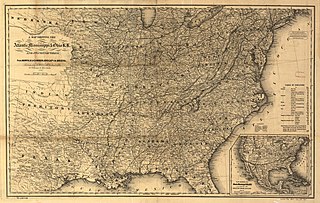
Atlantic, Mississippi and Ohio Railroad (AM&O) was formed in 1870 in Virginia from three east–west railroads which traversed across the southern portion of the state. Organized and led by former Confederate general William Mahone (1826-1895), the 428-mile (689 km) line linked Norfolk with Bristol, Virginia by way of Suffolk, Petersburg, Lynchburg, and Salem. The AM&O was promoted as a trade link to the west, and further expansion was envisioned with the goal of increasing Virginia's Ohio Valley and Mississippi Valley commerce. It was heavily backed by investors from England and Scotland.
Harold A. Reid (1925–1992), also known by the pen name H. Reid, was an American writer, photographer, and historian. Reid's photographs of steam locomotives, captured the last days of steam motive power on America's Class I railroads, notably on the Virginian Railway, and ending with the Norfolk and Western in 1960, the last major U.S. railroad to convert from steam.

The Roanoke Shops is a railroad workshop and maintenance facility in Roanoke, Virginia. Between 1884 and 1953, the shops produced 447 steam locomotives, all for the Norfolk and Western Railway (N&W). The Roanoke Shops built the N&W's famous Big Three class steam locomotives; the 4-8-4 class J, the 2-6-6-4 class A, and the 2-8-8-2 class Y6. In late 1953, the Shops built their final steam locomotive, making it last standard gauge steam locomotive built for revenue service in the United States. In 2020, N&W's successor, Norfolk Southern abandoned the Shops and Genesis Rail Services acquired the property in July 2023.
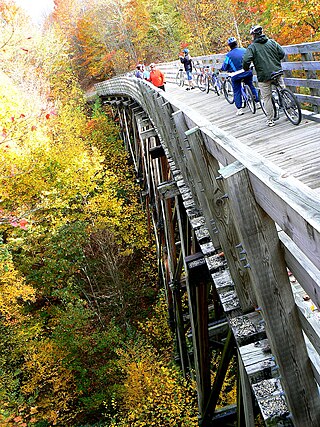
The Virginia Creeper Trail is a 35-mile (56 km) multi-purpose rail trail. Located in southwestern Virginia, the trail runs from Abingdon to Whitetop, Virginia, near Mount Rogers National Recreation Area and the North Carolina state line.
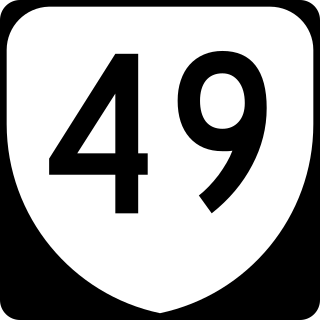
State Route 49 is a primary state highway in the U.S. state of Virginia. The state highway runs 69.01 miles (111.06 km) from the North Carolina state line in Virgilina, Virginia in Halifax County, where the highway continues south as North Carolina Highway 49, north to U.S. Route 360 near Burkeville in Nottoway County. SR 49 passes through Southside Virginia, connecting Virgilina and Burkeville with Clarksville and Chase City in Mecklenburg County, Victoria in Lunenburg County, and Crewe in Nottoway County. Via US 360, the state highway connects Richmond with the John H. Kerr Reservoir.

The Farmville and Powhatan Railroad went bankrupt in 1905 and became the Tidewater and Western Railroad. The line survived until 1917 when it was pulled up and sent to France for the World War I effort. The Tidewater and Western Railroad carried freight and passengers along a route from Farmville, Virginia to Bermuda Hundred. The Tidewater and Western Railroad continued to have Western Union Telegraphs run along the rails. These connected to telegraphs on the Atlantic Coast Line along the East Coast of the US and to Europe.
The Princeton–Deepwater District is a rail line in West Virginia that connects Deep Water, West Virginia, on the Kanawha River southwards to Princeton, West Virginia, and beyond to rail lines leading to Virginia. It is known for its rugged terrain and opportunities for rail photography.
